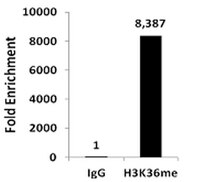17-10498 Sigma-AldrichChIPAb+ Monomethyl-Histone H3 (Lys36) - ChIP Validated Antibody and Primer Set
The ChIPAb+ Monomethyl-Histone H3 (Lys36) set includes the monomethyl-Histone H3 (Lys36) antibody, a Normal Rabbit IgG & control primers which amplify a 213 bp region of the human GAPDH coding reg
More>> The ChIPAb+ Monomethyl-Histone H3 (Lys36) set includes the monomethyl-Histone H3 (Lys36) antibody, a Normal Rabbit IgG & control primers which amplify a 213 bp region of the human GAPDH coding region. Less<<Recommended Products
Overview
Key Specifications Table
| Species Reactivity | Key Applications |
|---|---|
| M, H, R | WB, ChIP, IP, DB |
| Product Information | |
|---|---|
| Format | Affinity Purified |
| Control |
|
| Presentation | Anti-Monomethyl-Histone H3 (Lys36) (Rabbit Polyclonal). One vial containing 75 µL 0.35 mg/mL purified rabbit polyclonal in buffer containing 0.1 M Tris-Glycine (pH7.4),150mM NaCl, and 0.05% sodium azide, before the addition of 30% glycerol. Store at -20°C. Normal Rabbit IgG. One vial containing 125 µg Rabbit IgG in 125 µL storage buffer containing 0.05% sodium azide. Store at -20°C. ChIP Primers, GAPDH coding D2. One vial containing 75 μL of 5 μM of each primer specific for human GAPDH coding region. Store at -20°C. FOR: GCC ATG TAG ACC CCT TGA AGA G REV: ACT GGT TGA GCA CAG GGT ACT TTA T |
| Quality Level | MQ100 |
| Packaging Information | |
|---|---|
| Material Size | 25 assays |
| Material Package | 25 assays per set. Recommended use: 3 μL (1 μg) of antibody per chromatin immunoprecipitation (dependent upon biological context). |
| Global Trade Item Number | |
|---|---|
| Catalog Number | GTIN |
| 17-10498 | 04053252870408 |















 Antibody[209308-ALL].jpg)

